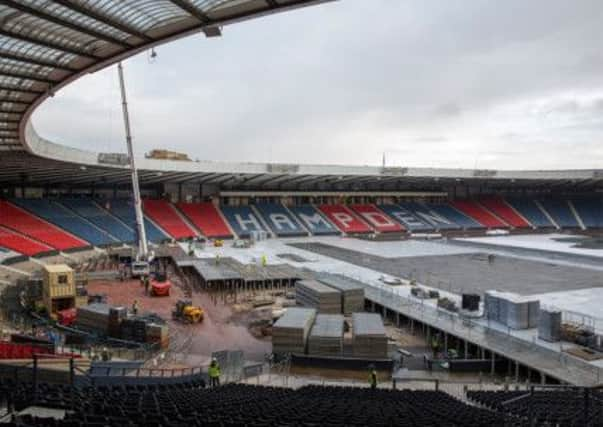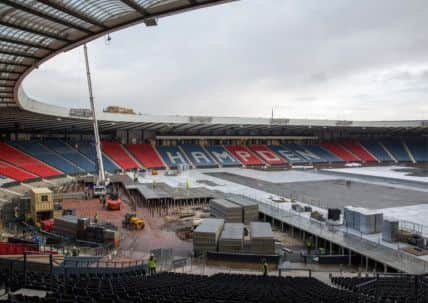Video: Hampden transformed for Glasgow 2014


Now, organisers of this summer’s Commonwealth Games hope the famous Hampden roar will cheer on the world’s track and field stars after lifting the veil on a new look for the home of Scottish football.
Officials yesterday revealed the purpose-built athletics infrastructure in the iconic stadium which included a “revolutionary” design they hope will allow competitors at Glasgow 2014 to achieve record-breaking times.
Advertisement
Hide AdAdvertisement
Hide AdThe £14 million project has transformed the venue in the south side of the city into an arena for world-class track and field events and has already been granted the crucial accreditation by the International Association of Athletics Federations (IAAF) in time for the Games.


While turf remains in the centre of the stadium, around the perimeter, an athletics track now hugs the stands where around 44,000 spectators will gather for the competition.
A closely-guarded secret, the work involved raising the stadium surface by almost two metres in order to gain the width and length required for an IAAF-approved track.
More than 1,200 base panel and 6,000 structural steel stilts were laid in Hampden to construct the temporary deck, with asphalt layered over stone in order to create a fine surface. And the recognisable red running track surface will be put in place next month.
Organisers are proud of what they call the “Glasgow solution” – given this is the first time such technology has been used on this scale to create a world-class athletics event and already athletics organisations the world over are taking note of the project. There have been concerns about the amount of flex in the elevated track, but organisers said there would be “give” in the artificial surface.
David Grevemberg, chief executive of Glasgow 2014, said: “We’re really proud of what we’ve accomplished so far. To have the platform built and solution working, we are absolutely delighted. It has been tested and tried in the east end of Glasgow about a year-and-a-half ago.”
Ian McKenzie, head of venue development at Glasgow 2014, explained: “It’s a world first. We looked around to see if it had been done before and it hadn’t. The same system was used in the London Olympics for the equestrian events, but that was in a park, not a stadium, so it was a different challenge.
“We’ve to finish putting the tarmac down and the specialist running track surface itself goes down next month. Once that’s done, it’s ready to go. It’s gone to plan, the deck has gone in exactly as we hoped it would.”
Advertisement
Hide AdAdvertisement
Hide AdOlympic gold medallist Jessica Ennis-Hill and champion hurdler Eilidh Child became the first athletes to view the new track yesterday.
With just four months to go until the first athletes arrive in Glasgow to move into their temporary home from home at the Athletes’ Village, both enthused about the new-look Hampden.
Ennis-Hill will not be competing at the Games as she is expecting her first child, but was full of praise for the work done so far.
“It’s nice to come and have a look at what it’s going to be like in July,” she said. “It looks fantastic, with the amount of work that’s gone into raising the level of the stadium, it looks brilliant already.”
Child, who took silver in the 400m hurdles at the 2010 Games, said: “I’ve not been able to get my head round how it would look until today.
“It’s really coming together and beginning to look like an athletes’ track now. It’s nice to see where the crowd are going to be and just get a feel for it.”
The athlete, who has previously been to the stadium as a Hearts supporter, added: “It still feels like the Hampden I know but it’s got added excitement now.
“I’ve seen Hampden in its football format many times, but I never thought I’d see it like this. It’s a spectacular transformation and I’m hugely excited to be competing here this summer. The thought of pushi ng down the home straight in front of a packed crowd inside our national stadium gives me goosebumps.” Mr McKenzie revealed organisers constructed a “mock up” of the track at a Clyde Gateway site in the east of the city in the summer of 2012 to test the plans, building a section of the track “in exactly the same way” as the construction project at Hampden. As part of the review, Scottish hurdler Chris Baillie ran on the temporary track, giving it his seal of approval.
Advertisement
Hide AdAdvertisement
Hide AdObservers will be watching closely when the London leg of the IAAF Diamond League meets at Hampden on 11 and 12 July, just weeks before the Games are due to be begin.
Mr McKenzie added he “hoped” the new facility would be a “fast track.” He said: “The surface we’ve chosen is the one that is used at all major events so we would hope it will be a fast track and I think one of the things that makes it fast is the fact the spectators are close to the action.
“That creates an atmosphere that will make the athletes perform at their best, and we’re hoping the athletes who come here will leave with a really good feeling.” After the Games, Hampden will be restored to a football venue, with its normal capacity of 52,000 reinstated. The track, however, could be moved to another venue elsewhere in Scotland.
“We are in discussions with sportscotland and others who are interested in relocating the track and our intention is that it will be relocated after the Games,” Mr McKenzie said. “It’s too early to say where but there are at least two organisations, if not more, interested.”
Shona Robison, the minister for Commonwealth Games and sport, pointed to the overhaul of the stadium as a sign that the city was “on track for a spectacular Games.” She said: “Hampden is being transformed for these Games and the raised playing surface is a fantastic example of innovation. It shows how we are making the best use of existing facilities to deliver world-class athletics in Glasgow.”